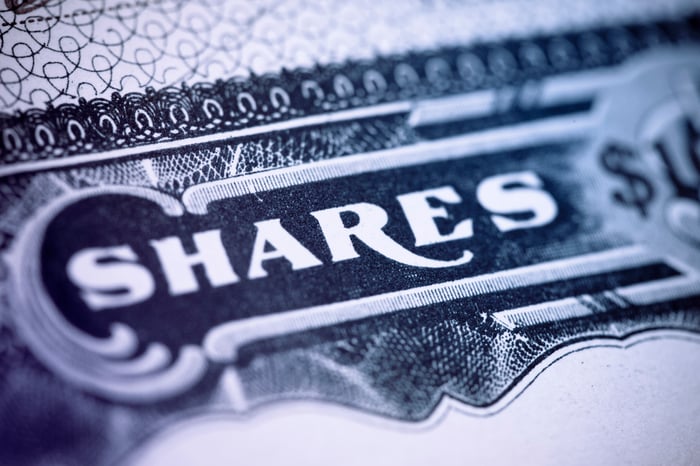There's little question that artificial intelligence (AI) has played an important role in sending the broad-based S&P 500, ageless Dow Jones Industrial Average, and growth-inspired Nasdaq Composite to record highs. But this isn't the only trend that's inciting optimism on Wall Street.
In addition to the AI revolution, investors have been captivated by stock splits in some of Wall Street's most-influential businesses.
A stock split is an event where a publicly traded company adjusts its share price and outstanding share count by the same factor. These changes are entirely cosmetic, as they don't have any impact on a company's underlying operating performance or its market cap.

Image source: Getty Images.
Even though these changes are purely superficial, they can generate markedly different reactions from investors. Reverse splits, which are designed to increase a company's share price, are generally avoided. This type of split is usually undertaken by struggling businesses that are attempting to avoid delisting from a major stock exchange.
Comparatively, investors have traditionally flocked to companies announcing and completing forward stock splits. This form of split lowers a company's share price to make it more nominally affordable for retail investors who aren't able to buy fractional shares with their broker. If a public company needs to reduce its share price to make its stock more accessible to everyday investors, it's typically doing something right from an operating and innovative standpoint.
It's been a year of non-tech stock-split stocks
In 2024, Wall Street was flush with tech-based stock-split stocks. In fact, some of the most prominent splits of the year could be traced to leaders in the AI space. This included respective 10-for-1 forward splits for Nvidia, Broadcom, Lam Research, and Super Micro Computer.
Though forward splits have been fewer and far between in 2025, there's been a decisive shift away from technology. This year, it's been all about high-profile non-tech stock splits.
For instance, automated electronic brokerage firm Interactive Brokers Group (IBKR 0.94%) made history by completing its first-ever split (4-for-1) after the close of trading on June 17. To make its year even more historic, Interactive Brokers replaced the now-private pharmacy chain Walgreens Boots Alliance in the S&P 500 in late August.
The aggressive investments Interactive Brokers made in automation have begun to really pay off and differentiate its service from other online brokers. The cost advantages it possesses have allowed the company to pay higher interest on customer cash balances, as well as charge lower margin loan rates, when compared to other online brokers. Not surprisingly, Interactive Brokers Group's key performance indicators are climbing by double digits across the board.
It's also been a banner year for wholesale industrial and construction supplies company Fastenal (FAST 1.25%), which completed its ninth forward split (2-for-1) in May since going public in August 1987. You could rightly say that stock splits have become part of the Fastenal corporate culture.
Aside from being a cyclical company that benefits from the nonlinearity of the economic cycle, Fastenal's leading catalyst is its innovation. Its internet-connected, on-site wireless vending machines and FASTBin electronic inventory solutions help clients stay on top of their inventory, and makes Fastenal an integral part of industrial supply chains.
But these two companies, arguably, play second fiddle to Wall Street's preeminent stock-split stock of 2025: auto parts supplier O'Reilly Automotive (ORLY -0.62%).

Image source: Getty Images.
O'Reilly has one of Wall Street's most impressive share repurchase programs
In mid-March, O'Reilly's board announced an ambitious plan to conduct the company's largest-ever split (15-for-1). With the blessing of its shareholders at the company's annual meeting, O'Reilly moved ahead with its record-breaking split after the close of trading on June 9.
Since its initial public offering in April 1993, O'Reilly Automotive shares have burned rubber and rallied more than 62,400%, as of the closing bell on Oct. 17. This is a reflection of macro factors working in its favor, as well as smart decision-making on the part of the company's board and executive team.
From a broad standpoint, the aging of vehicles on U.S. roadways is a clear catalyst. The latest annual analysis from S&P Global Mobility, a division of the more-familiar S&P Global, notes the average age of vehicles on U.S. roadways has risen to 12.8 years in 2025 from 11.1 years in 2012. Drivers and businesses hanging onto their vehicles for a longer period makes it likelier that they and/or mechanics will be turning to auto parts chains like O'Reilly to keep these cars and trucks in tip-top running condition.
Management has also made a clear effort to improve O'Reilly Automotive's supply chain. Though it's leaning into AI for forecasting and inventory tracking like most retailers, it's the company's hub-and-spoke distribution model that's making waves. O'Reilly entered the year with 31 distribution centers and just shy of 400 hub stores. These hub stores can get more than 153,000 stock keeping units (SKUs) to its over 6,000 retail locations on a same-day or overnight basis to ensure what customers need is always accessible.
But what makes O'Reilly Automotive Wall Street's preeminent stock-split stock of 2025 is its impressive share repurchase program, which is among the best on the planet.
The company's board kicked off a buyback program in January 2011 and has spent an aggregate of $26.59 billion to repurchase its shares. In less than 15 years, O'Reilly Automotive's buybacks have retired nearly 60% of its outstanding shares. For a company that's delivering steady revenue and profit growth, a sizable buyback program can provide a meaningful lift to earnings per share (EPS).
Though O'Reilly Automotive stock isn't exactly cheap at roughly 30 times forward-year earnings, all of the necessary puzzle pieces for future share-price appreciation are firmly in place for 2025's top stock-split stock.





